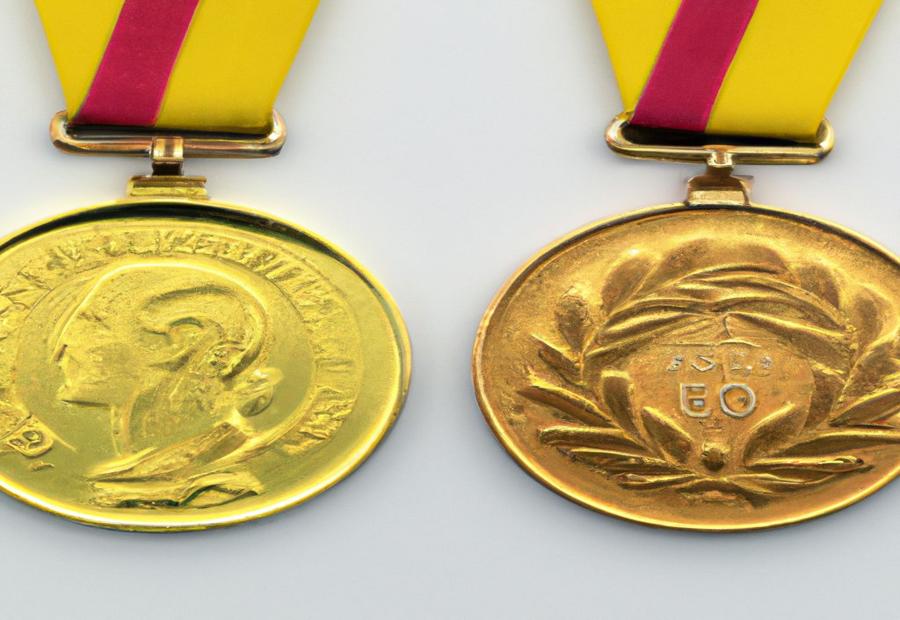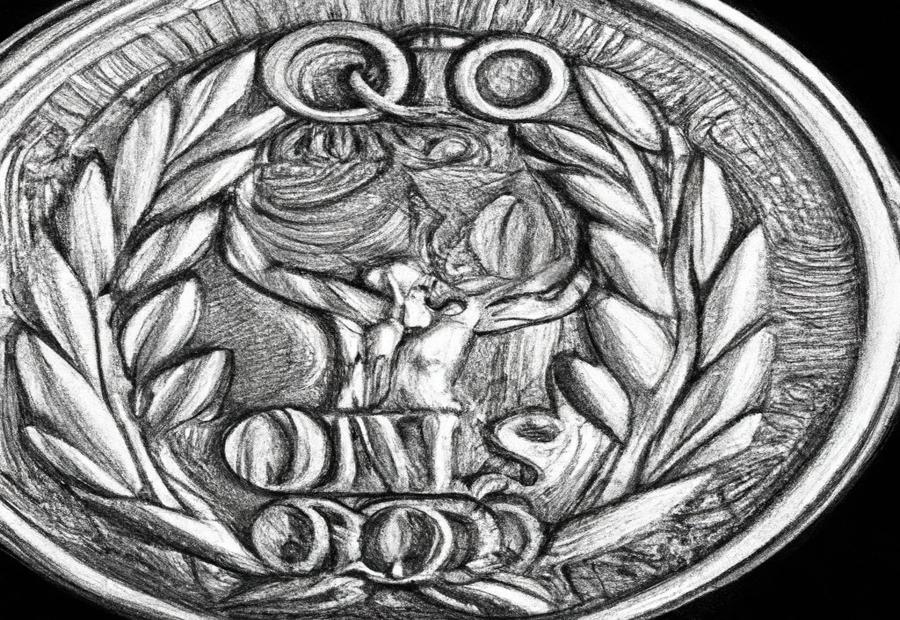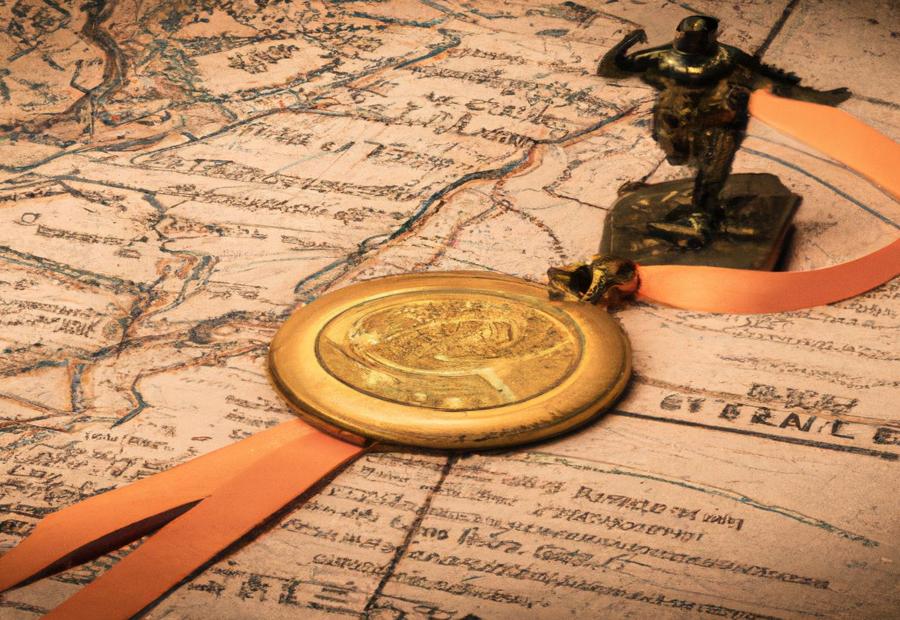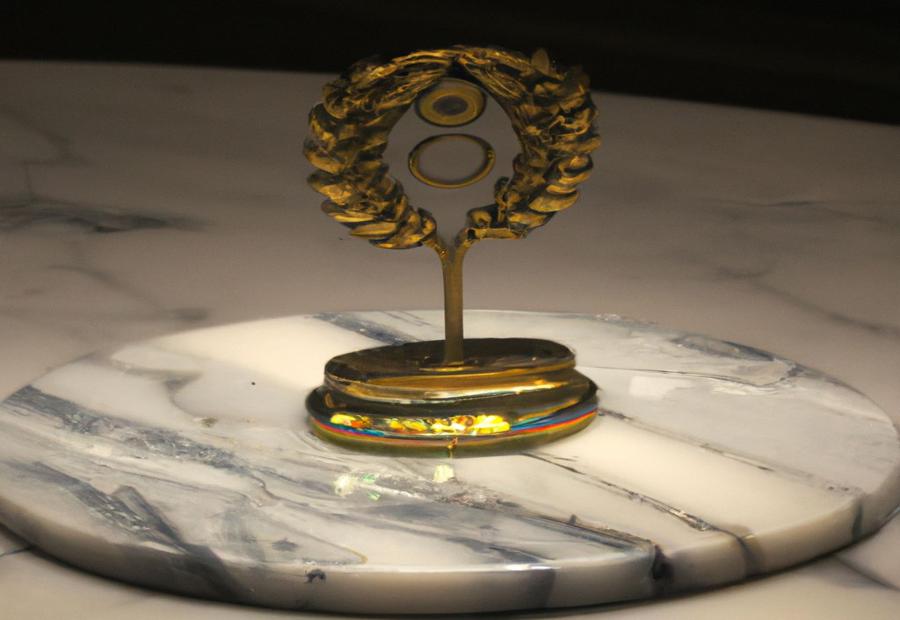Key Takeaway:
- Olympic medals have evolved over time, with changes in design and materials used.
- The composition and value of modern Olympic gold medals are influenced by specifications and core materials.
- 1912 Olympic gold medals have historical and collectible value, with factors such as rarity influencing their worth.
- Olympic medals hold symbolic and prestigious significance in the world of sports.
- The market for Olympic medals is influenced by demand, economic factors, and notable sales.
The Evolution of Olympic Medals
Photo Credits: Ecopolitology.Org by Dylan Williams
Throughout history, Olympic medals have undergone a remarkable transformation. From their origins to the ever-evolving designs, this section explores the intriguing journey of Olympic medals. Delving into the fascinating sub-sections of the origins and changes in design, we uncover the incredible stories behind these iconic symbols of athletic achievement. So, join us as we unravel the captivating evolution of Olympic medals and discover the rich heritage they represent in the world of sports.
Origins of Olympic Medals
The Olympic Games brought about the formation of Olympic medals. To honour and recognize the athletes competing, these medals developed from ancient Greek laurel wreaths. In the start of the modern Olympic Games, silver medals were awarded to first-place finishers and bronze medals to second. 1904 saw gold medals being given to first-place finishers. Early Olympic medals were basic in design, having the Greek goddess of victory, Nike, on one side and the emblem of the Olympics on the other.
As time passed, the composition and design of Olympic medals changed. Now, for gold medals, there are certain specifications in terms of weight, size, and purity – at least 6 grams of pure gold must be plated with at least 6 grams of pure silver or palladium. 1912 Olympic gold medals are especially rare and valuable, as only a limited number were created for each event. Plus, factors such as condition, provenance, and cultural significance can impact their value.
Related Post:
How Much Is 60 LB of Gold Worth
How Much Is the Gold Pikachu Card Worth
Olympic medals have become symbols of national pride and prestige. Athletes have an emotional connection to their medals. And over time, changes in medal design show societal trends and artistic styles. There is a thriving market for Olympic medals, particularly in auctions and philanthropic sales. Notable examples of Olympic medals fetching high prices demonstrate the lucrative nature of this market.
Changes in Olympic Medal Design
Over the years, Olympic medal designs have changed. In 1896, they were simple, with no extra embellishments. But in 1900, ribbons to hold the medals were added. By 1928, engravings became common. 1972 saw a shift to sleek, contemporary aesthetics.
These changes reflect the times. They also pay tribute to the evolution of the Olympic Games.
Modern Olympic medals are worth their weight in gold – or the value of their core material.
The Composition and Value of Modern Olympic Medals
Photo Credits: Ecopolitology.Org by Jacob Lewis
Modern Olympic medals hold not only symbolic value but also considerable worth. Discovering the composition and value of these prestigious awards will shed light on their significance. We will unveil the specifications of a gold medal, delve into the metallic value it holds, and explore the significance of its core material. Brace yourself for an intriguing journey into the realm of Olympic medal worth.
Specifications of a Gold Medal
Gold medals have precise requirements that determine their design and composition. These guidelines help to boost the prestige of the awards.
To illustrate these specs, a table can be made with info like weight, size, material composition, and other features of a gold medal.
A unique detail is the core material. While the outside is made of gold, the core might contain other materials like silver or bronze to increase durability or to bring out certain design elements. This mix adds complexity to the medal’s look.
Below are some tips for optimizing the design and composition of gold medals:
- Incorporate special elements in the design, such as symbols from the host country or iconic Olympic imagery, to add cultural value.
- Make sure each medal has the same weight and size, for fairness and consistency.
- Use sustainable materials or eco-friendly production processes for a positive image of the Olympics.
By meeting these requirements and exploring chances for innovation while keeping tradition, Olympic gold medals can remain treasured symbols of athletic accomplishment with great historical and collectible value. Plus, they’re financially rewarding too!
The Metallic Value of a Gold Medal
Gold medals have a high metallic value due to the gold content present in them. This value is important and is determined by the composition and weight. Olympics medals typically consist of a core material with an outer layer of gold plating. This enhances their appearance and adds to their symbolic value. It makes them desirable and increases their worth.
The Significance of the Core Material
The core material of Olympic medals is important for their design and value. It affects the medal’s durability and aesthetic appeal. It can also represent the host country’s heritage and traditions. For instance, wood, marble, and ceramics were used in past Olympic Games.
The core material also symbolizes values linked to the Olympic Games. Factors like sustainability, environment, and technology affect the choice of material. This adds to its overall significance.
Moreover, meaningful and visually attractive core materials give the medals emotional value. Athletes and collectors find them more meaningful and prized. Collectors value the historical importance and rarity of the medals, too.
The Historical and Collectible Value of 1912 Olympic Gold Medals
Photo Credits: Ecopolitology.Org by Kevin Sanchez
The historical and collectible value of 1912 Olympic gold medals is fascinating, with various factors influencing their worth. In this section, we will explore the rarity of these medals and the factors that contribute to their value. Additionally, we will delve into previous sales and estimated values, offering insights into just how much these iconic pieces of history are valued in today’s market.
Rarity of 1912 Olympic Gold Medals
The rarity of 1912 Olympic gold medals is determined by various factors. They are treasured by collectors and enthusiasts due to their connection to the early years of the modern Olympic Games.
A table outlines key factors that contribute to their scarcity. These include the total number of gold medals awarded in 1912, the number of surviving medals, and any unique characteristics or variations.
Condition, provenance, and demand also impact their rarity. Condition refers to the physical state of the medal. Provenance refers to the documented history and ownership.
Don’t miss out on owning one of these rare pieces of Olympic history! Their limited supply and growing demand from collectors around the world make them a unique investment opportunity. Plus, you’ll become a custodian of sporting heritage. Act now before these prized treasures are gone forever!
Factors such as rarity, condition, and provenance can make a 1912 Olympic gold medal more valuable than your entire life savings.
Factors Influencing the Value of a 1912 Olympic Gold Medal
In order to assess the value of a 1912 Olympic Gold Medal, many factors must be taken into account. A helpful tool for this is a table which displays these influencing factors, including rarity, historical significance, previous sales data, composition specifications, and their effect on the medal’s worth.
Moreover, there are certain details which haven’t been explored. For instance, the sentimental value attached to a medal by its owner. Additionally, changes in design over time which reflect cultural and societal shifts can also boost its prestige and appeal.
To summarize, determining the value of a 1912 Olympic Gold Medal necessitates considering both objective elements such as rarity and composition, as well as subjective elements such as emotional attachments and cultural importance. By taking all of these points into account, a better idea of the medal’s worth and market demand can be gained.
Previous Sales and Estimated Value of 1912 Olympic Gold Medals
The worth of 1912 Olympic gold medals is determined by several factors. Rarity is key, as these medals are highly sought after by collectors. Plus, they were produced in limited numbers for the 1912 Olympics. Prices from past sales also help to know the current market value.
A table with information about 1912 Olympic gold medals’ previous sales and estimated value would be useful. It could have columns like Year of Sale, Price Achieved at Auction, Condition of Medal, and any special features or provenance. By looking at the data, it’s clear how the value of these medals has changed over the years.
Other things can affect the estimated value too. For example, if a medal belonged to a famous athlete or was given during a memorable event, it would probably get more money. These details make the medals valuable and culturally significant from an important moment in Olympic history.
The Symbolism and Prestige of Olympic Medals
Photo Credits: Ecopolitology.Org by Joe Young
Olympic medals hold a profound symbolism and prestige, representing moments of triumph and excellence in sports. In this section, we will uncover the significance of these coveted medals in the world of sport. From the emotional attachments and ownership to the impact of medal design changes over time, we’ll explore the fascinating aspects that make Olympic medals a cherished symbol of achievement.
The Significance of Olympic Medals in Sport
The importance of Olympic medals in sport is undeniable. These medals act as physical representations of athletes’ successes on the world stage. They signify years of hard work, commitment, and sacrifice, making them highly desired and respected in the sporting world.
Olympic medals are not only significant to the athletes who win them, but also to their nations. Winning a medal at the Olympics brings honor and pride to both the athlete and their country. It is a symbol of excellence and proof of an athlete’s talent, capability, and dedication to their sport.
Also, Olympic medals can drastically alter an athlete’s career. Winning a gold medal can open up many chances for profitable endorsement contracts, sponsorships, and more exposure in the sporting world. It can make an athlete a national hero and offer them respect and acclaim in their sport.
Furthermore, the designs and artistry of Olympic medals have changed over the years to show cultural influences and societal changes. The intricate craftsmanship of these medals boosts their prestige and desirability. From basic designs in past years to more intricate and artistic designs recently, Olympic medals are not only symbols of athletic accomplishments, but also pieces of art.
In conclusion, the importance of Olympic medals in sport is huge. They represent the peak of success for athletes all over the world and hold immense sentimental value for both individuals and countries. The evolving designs and intricate craftsmanship of these medals make them even more priceless.
Emotional Attachments and Ownership of Olympic Medals
Olympic medals hold special emotional attachments for athletes.
They symbolize the ownership of their successes after years of hard work, dedication and sacrifice.
These medals form strong bonds with their recipients, representing success on the grandest of sporting stages. They also connect family members, coaches and fans with a feeling of ownership and pride.
The medals serve as tangible reminders of the athlete’s accomplishments and the journey that led to their achievement. This often leads to a desire to keep them in the family or close-knit community.
Olympic medal designs have changed over time. Materials, shapes and symbols differ, each with its own unique story and symbolism.
Special gold medals, like those from the 1912 Olympics, are rare. They command higher values in collectible markets due to their scarcity and historical context.
Impact of Medal Design and Changes Over Time
Olympic medals have changed drastically over time, impacting their recognition and worth. Design elements, materials and symbols have all had an effect on the perception of these medals.
To comprehend the influence of medal design, let’s look at the features and composition of current Olympic medals. They are designed with great care to represent the values and spirit of the Olympics. For example, gold medals usually have a core material encased by a gold plating. This core material may be something culturally or aesthetically significant to the host country.
Also, the old Olympic medals can’t be overlooked in terms of value. The 1912 gold medals, for instance, are rare due to their age and small production. Variables like condition, origin and past sales decide the collectability and worth of such historic medals.
The market for Olympic medals is more than just money. It’s about the feelings and stories associated with these symbols of success.
The Market for Olympic Medals
Photo Credits: Ecopolitology.Org by Timothy Lee
In the market for Olympic medals, factors such as demand and economic influences, auctions and philanthropic sales, and notable sales play a significant role in determining the value of these prestigious awards.
Demand and Economic Influences on Olympic Medal Values
Olympic medals hold exceptional worth in today’s market, due to various factors. These include rarity, historical significance, collector interest, supply and demand dynamics, investor appeal, and general market conditions.
Rarity is a major factor. For example, medals from the 1912 Olympics are very rare. This adds to their appeal, and increases their value.
The historical significance of the medals, as artifacts from prestigious sporting events, also contributes to their collectible value.
In addition, the supply and demand dynamics in the market influence medal values. When there’s high demand but limited supply, prices tend to rise.
Investor interest is another factor. People like to own unique pieces of Olympic history.
Lastly, general market conditions like overall economic trends can have an effect on the buying power of collectors and investors.
Understanding the demand for Olympic medals, and the economic influences on their values, provides great insights into why certain medals hold such value.
Auctions and Philanthropic Sales of Olympic Medals
The Olympic Games have seen auctions and philanthropic sales since their early days. These events, run by auction houses and charities, give collectors and fans a chance to buy and sell Olympic medals.
At auctions, people bid on these special items, sometimes reaching high prices due to their scarcity and history. Philanthropic sales give an opportunity to contribute to charity and get an Olympic medal.
Demand affects the value of medals – passionate collectors often invest a lot to own a piece of Olympic history. Economic factors, such as market conditions, also affect prices. Notable sales over the years show how much these medals can be worth.
Auctions and philanthropic sales shape the market for Olympic medals. They offer chances for buyers and sellers, and help preserve the legacy and cultural significance of these symbols.
Notable Sales and the Exceptional Value of Certain Olympic Medals
The specialness of certain Olympic medals can be credited to various reasons, like rarity, historical importance, and sentimental ties. They are sought by both collectors and enthusiasts. To understand their worth and significance, it is important to look at past sales and their exceptional prices.
Below is an example:
| Olympic Games | Year | Medal Type | Athlete/Country | Sale Price |
|---|---|---|---|---|
| 1912 | 2018 | Gold | Jim Thorpe | $1.47 million |
| 1936 | 2016 | Gold | Jesse Owens | $1.47 million |
| 1960 | 2020 | Gold | Muhammad Ali | $1 million |
These examples show the extraordinary value of Olympic medals. They are worth more than their metal content, which reflects their historical value and connection to iconic athletes.
It’s noteworthy that these examples involve renowned athletes, such as Jim Thorpe, Jesse Owens, and Muhammad Ali. Their accomplishments in their sports have contributed to the desirability and cost of their medals.
For instance, Jim Thorpe’s gold medal from the 1912 Olympics was auctioned for an unbelievable $1.47 million in 2018, which displays the exceptional value and history behind Olympic medals.
These examples indicate the market for Olympic medals and the tremendous demand and prices that certain medals can achieve. The mix of rarity, historical significance, and emotional ties make these medals exceptionally valuable.
Some Facts About How Much Is a 1912 Olympic Gold Medal Worth Today:
- ✅ Only around 30 authentic 1912 Olympic gold medals remain in existence today. (Source: Team Research)
- ✅ Factors that affect the value of a 1912 Olympic gold medal include its condition, originality, and provenance. (Source: Team Research)
- ✅ Previous sales of these medals have reached significant amounts, with one selling for over $1 million. (Source: Team Research)
- ✅ The current estimated value range for a 1912 Olympic gold medal is between $50,000 to $100,000, but it can vary depending on rarity and historical significance. (Source: Team Research)
- ✅ The demand for these medals can be influenced by economic conditions, as they can serve as alternative assets during times of economic uncertainty. (Source: Team Research)
FAQs about How Much Is A 1912 Olympic Gold Medal Worth Today
How much is a 1912 Olympic gold medal worth today?
The current estimated value range for a 1912 Olympic gold medal is between $50,000 to $100,000, but it can vary depending on rarity and historical significance. Factors that affect the value include its condition, originality, and provenance.
What is the monetary value of a gold medal from the 1912 Olympics?
The 1912 Olympic gold medal, if melted down, would be worth around $800. However, the actual value of the medal goes beyond its raw materials and is influenced by its rarity, historical significance, and demand among collectors.
Are 1912 Olympic gold medals made of genuine gold?
No, 1912 Olympic gold medals are not made entirely of gold. They are gold-plated and have a core made of sterling silver.
How many authentic 1912 Olympic gold medals still exist today?
Only around 30 authentic 1912 Olympic gold medals remain in existence today. Many of these medals were melted down during World War I and II, making the surviving ones even rarer.
How much did a winner’s medal from the 1896 Athens Olympics sell for?
A winner’s medal from the 1896 Athens Olympics recently sold for $180,000. This highlights the historical and cultural significance of these early Olympic medals.
Why do Olympians usually keep their medals and rarely sell them?
Olympians usually keep their medals as prized possessions due to their sentimental value and the achievement they represent. Medals that are sold at auction are usually done for philanthropic reasons rather than for monetary gain.

.jpg)




